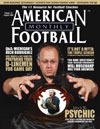AMERICAN FOOTBALL MONTHLY THE #1 RESOURCE FOR FOOTBALL COACHES
Article CategoriesAFM Magazine
|
Michigan\'s Rich Rodriguezby: Mike KucharSenior Writer, American Football Monthly © More from this issue There is no doubt that Rich Rodriguez has continued to establish himself as one of the premier coaches in college football. Known as the modern grandfather of the spread offense, Rodriguez has continued to establish quick strike offenses while developing even more explosive players to lead it. Now after taking the West Virginia program to new heights by making them a perennial national title contender, Rodriguez has his biggest challenge in front of him – as the new head coach of Michigan. The interview with Rodriguez is the first in a series of in-depth Q&A sessions hosted by senior writer Mike Kuchar with the intent of addressing all aspects relative of football – from scheme to philosophy – with the game's most innovative and well-respected minds. Q: This is the second time that you’ve taken ....The full article can only be seen by subscribers. Subscribe today!
|
|
|||||||
| HOME |
MAGAZINE |
SUBSCRIBE | ONLINE COLUMNISTS | COACHING VIDEOS |
Copyright 2025, AmericanFootballMonthly.com
All Rights Reserved





